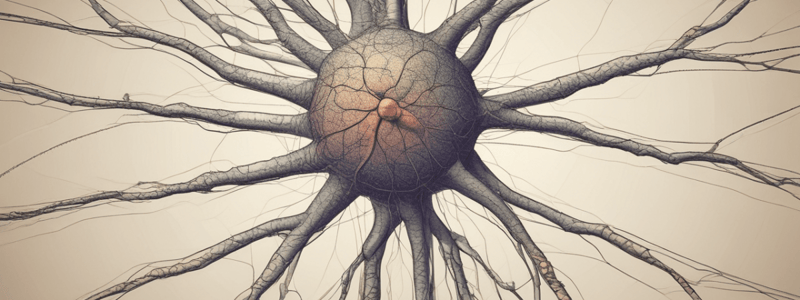Podcast
Questions and Answers
What is the primary function of neuroglia in the nervous system?
What is the primary function of neuroglia in the nervous system?
- To facilitate learning and memory
- To transmit information between neurons
- To provide support, protection, and maintenance for neurons (correct)
- To regulate body temperature
Which part of a neuron is responsible for carrying signals away from the cell body?
Which part of a neuron is responsible for carrying signals away from the cell body?
- Cell body
- Axon (correct)
- Dendrites
- Terminal buttons
What is the term for the gap between the terminal button of one neuron and the dendrite of another?
What is the term for the gap between the terminal button of one neuron and the dendrite of another?
- Dendrite
- Synapse (correct)
- Neurotransmitter
- Receptor
What is the resting potential of a neuron due to?
What is the resting potential of a neuron due to?
Which type of neurotransmitter would increase the likelihood of an action potential?
Which type of neurotransmitter would increase the likelihood of an action potential?
What is the process of converting sensory stimuli into electrical signals?
What is the process of converting sensory stimuli into electrical signals?
What is the term for the modification of synaptic strength based on experience?
What is the term for the modification of synaptic strength based on experience?
What is the term for the growth and development of new neurons?
What is the term for the growth and development of new neurons?
Flashcards are hidden until you start studying
Study Notes
Functions of Nervous Tissue
- Controls and coordinates body functions
- Interprets and responds to sensory information
- Facilitates communication between different parts of the body
- Enables learning, memory, and behavior
Types of Nervous Tissue
- Neurons (nerve cells): responsible for transmitting information
- Neuroglia (glial cells): provide support, protection, and maintenance for neurons
Structure of a Neuron
- Dendrites: receive signals from other neurons
- Cell body: contains the nucleus and maintains the cell
- Axon: carries signals away from the cell body
- Terminal buttons: release neurotransmitters to transmit signals
Neurotransmission
- Synapse: gap between the terminal button of one neuron and the dendrite of another
- Neurotransmitters: chemical messengers released by terminal buttons to transmit signals
- Receptors: specialized proteins on the surface of dendrites that bind to neurotransmitters
Action Potential
- Resting potential: -70mV, due to higher concentration of K+ ions inside the cell and Na+ ions outside
- Threshold potential: -55mV, when the neuron becomes excited
- Depolarization: rapid increase in voltage due to influx of Na+ ions
- Repolarization: rapid decrease in voltage due to efflux of K+ ions
- Refractory period: period during which the neuron cannot generate another action potential
Types of Neurotransmitters
- Excitatory: increase the likelihood of an action potential (e.g. glutamate, aspartate)
- Inhibitory: decrease the likelihood of an action potential (e.g. GABA, glycine)
- Modulatory: influence the strength of synaptic transmission (e.g. dopamine, serotonin)
Neurophysiological Processes
- Sensory transduction: conversion of sensory stimuli into electrical signals
- Synaptic plasticity: modification of synaptic strength based on experience
- Neurogenesis: growth and development of new neurons
Functions of Nervous Tissue
- Controls and coordinates body functions, such as movement, sensation, and cognitive processes
- Interprets and responds to sensory information from the environment
- Facilitates communication between different parts of the body, enabling integrated functioning
- Enables learning, memory, and behavior through complex neural processes
Types of Nervous Tissue
- Neurons (nerve cells): transmit information through electrical and chemical signals
- Neuroglia (glial cells): provide structural support, protection, and maintenance functions for neurons
Structure of a Neuron
- Dendrites: receive signals from other neurons, allowing for integration of multiple inputs
- Cell body: contains the nucleus, maintains the cell, and coordinates neuronal activity
- Axon: carries signals away from the cell body, enabling long-distance communication
- Terminal buttons: release neurotransmitters, transmitting signals to other neurons or cells
Neurotransmission
- Synapse: small gap between neurons, allowing for chemical communication
- Neurotransmitters: chemical messengers released by terminal buttons, binding to receptors on adjacent neurons
- Receptors: specialized proteins on the surface of dendrites, recognizing and responding to neurotransmitters
Action Potential
- Resting potential: -70mV, maintained by the balance of potassium and sodium ions
- Threshold potential: -55mV, when the neuron becomes excited and generates an action potential
- Depolarization: rapid increase in voltage due to influx of sodium ions, triggering the action potential
- Repolarization: rapid decrease in voltage due to efflux of potassium ions, restoring the resting state
- Refractory period: period during which the neuron cannot generate another action potential, ensuring proper signaling
Types of Neurotransmitters
- Excitatory: increase the likelihood of an action potential, such as glutamate and aspartate
- Inhibitory: decrease the likelihood of an action potential, such as GABA and glycine
- Modulatory: influence the strength of synaptic transmission, such as dopamine and serotonin
Neurophysiological Processes
- Sensory transduction: conversion of sensory stimuli into electrical signals, enabling perception and response
- Synaptic plasticity: modification of synaptic strength based on experience, enabling learning and memory
- Neurogenesis: growth and development of new neurons, occurring throughout life
Studying That Suits You
Use AI to generate personalized quizzes and flashcards to suit your learning preferences.




